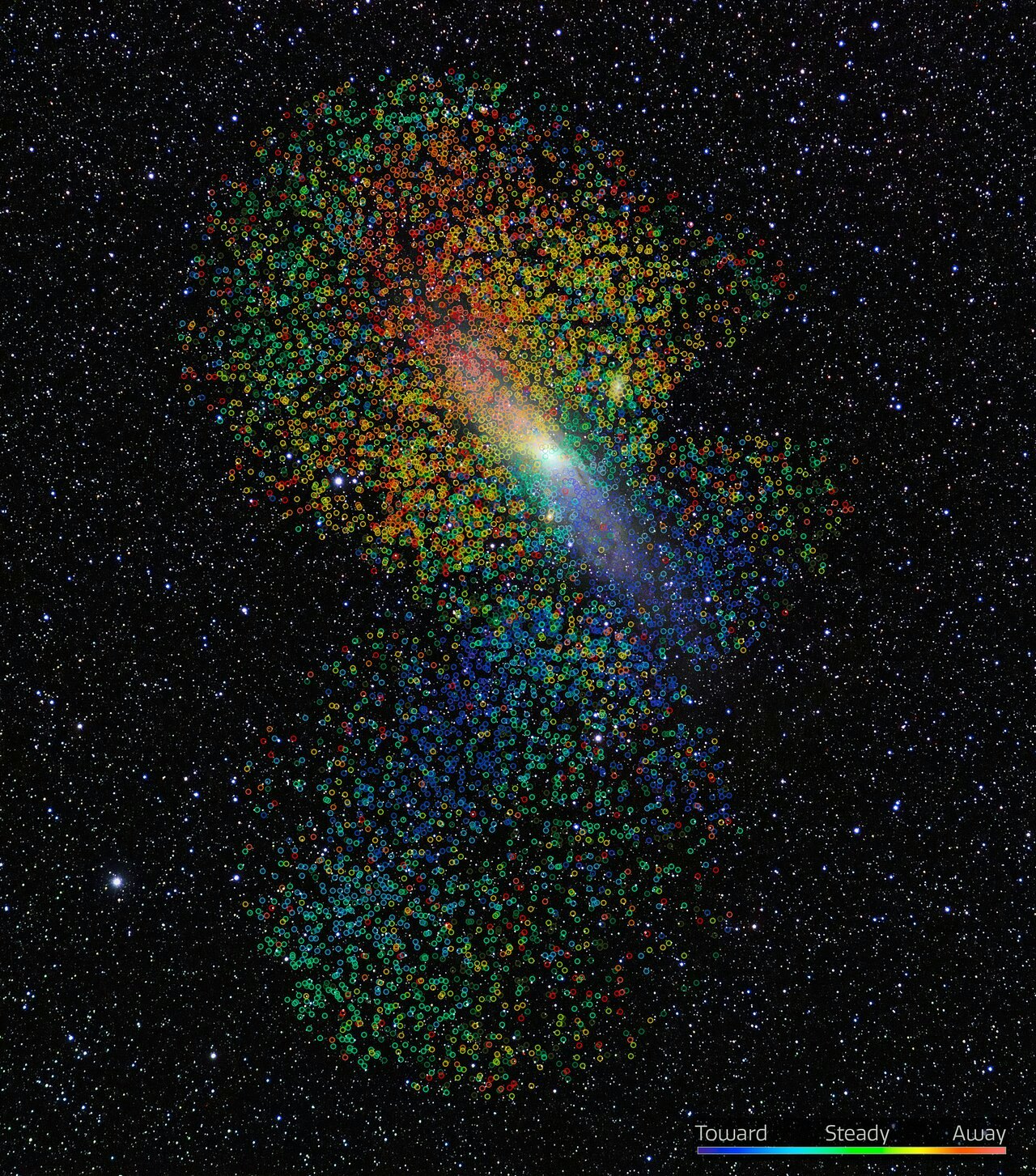
Someday, the Andromeda Galaxy will merge with our Milky Way – and it won’t be the first time Andromeda has swallowed up another galaxy and kept the stars for itself.
The nearby Andromeda Galaxy, like most galaxies, is made of more than just the familiar disk with its graceful arms. A spherical halo of stars and gas surrounds the disk — and many of the stars in that halo are the remnants of another galaxy, swallowed up in a merger two billion years ago.
A team of astronomers led by NOIRLab astronomer Arjun Dey published their findings in a recent paper in The Astrophysical Journal.
What’s New
Dey and his colleagues measured the motion of about 7,500 stars in the halo of matter around the nearby Andromeda Galaxy. When the astronomers traced how large groups of stars moved in different areas of the galaxy, the astronomers noticed patterns and structures in the motion. And those patterns suggested that many of Andromeda’s stars were actually born in a whole different galaxy.
Here in our Solar System, we can look at how a moon orbits a planet and get some clues about whether the moon formed from debris already orbiting the planet or whether it was a stray object caught by the planet’s gravity. Similarly, the way many of Andromeda’s stars move around the center of the galaxy seems to match what computer simulations predict for the aftermath of an ancient cosmic merger, in which Andromeda absorbed a smaller galaxy.
Today, all that’s left of that smaller galaxy are thousands of stars in Andromeda whose orbits hint at their origins.

Here’s the Background
For years, astronomical theories have predicted that the motions of stars should reveal ancient collisions between galaxies, but this recent study is the first time astronomers have managed to do this kind of “cosmic paleontology” in a galaxy outside our own Milky Way. Instead of looking at fossils and layers of rock to understand the history of a planet, astronomers study the motion and chemical makeup of stars to understand the history of a whole galaxy.
“It’s amazing that we can look out at the sky and read billions of years of another galaxy’s history as written in the motions of its stars,” says NOIRLab astronomer Joan Najita, a coauthor of the recent study, in a statement to the press. “Each star tells part of the story.”
Although the recent Andromeda Galaxy observations are the first time stars’ motion has helped reconstruct a galactic merger, there are other ways of untangling a galaxy’s complicated history. In a 2021 study, a different team of astronomers studied the chemical makeup of red giant stars in the Large Magellanic Cloud (a dwarf galaxy that orbits the Milky Way), and they found that at least one densely-packed star cluster in the Large Magellanic Cloud is basically a stellar fossil left over from an even smaller galaxy that the Large Magellanic Cloud once gobbled up. It’s a common event in the lifespan of a galaxy.
Why It Matters
Studying how stars migrated into Andromeda during its relatively recent merger could shed some light on our own galaxy’s backstory — and eventual fate.
“Galaxies like M31 [Andromeda] and our Milky Way are constructed from the building blocks of many smaller galaxies over cosmic history,” says Dey in a recent statement. Most of the stars in our galactic halo also formed in another galaxy, which merged with the Milky Way between eight and ten billion years ago.
“Our emerging picture is that the history of the Andromeda Galaxy is similar to that of our own galaxy, the Milky Way,” says University of Edinburg astrophysicist Sergey Koposov in a recent statement. “The inner halos of both galaxies are dominated by a single immigration event.” In other words, most of the imported stars Dey and his colleagues found in Andromeda came from just one other galaxy that merged with Andromeda – not a series of small mergers. And our Milky Way’s history seems to be pretty similar in that way.
And about five billion years from now, we’ll collide and merge with Andromeda.
What’s Next
Dey and his colleagues say the 7,500 stars in their recent study were just a sample; now they plan to survey all the visible stars in Andromeda’s galactic halo.
They’ll use the same instrument they used for the recent study: the Dark Energy Spectroscopic Instrument mounted on the fifty-year-old Mayall Telescope at Kitt Peak National Observatory. The instrument was originally designed to map galaxies and quasars to help astronomers measure how fast the universe is expanding.







